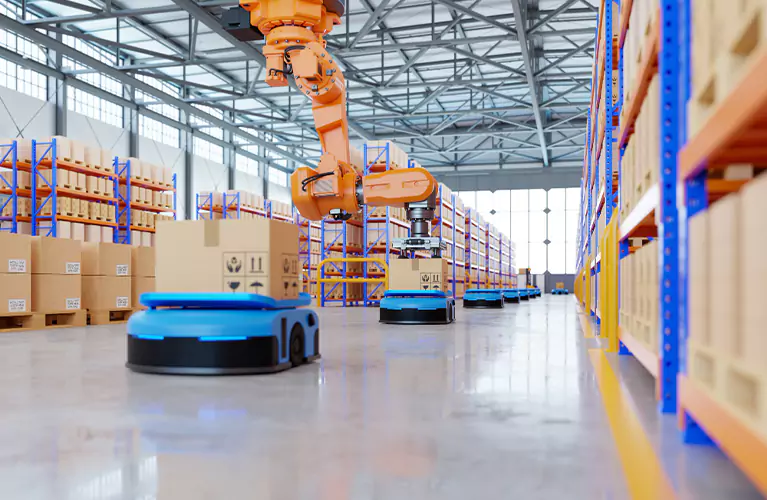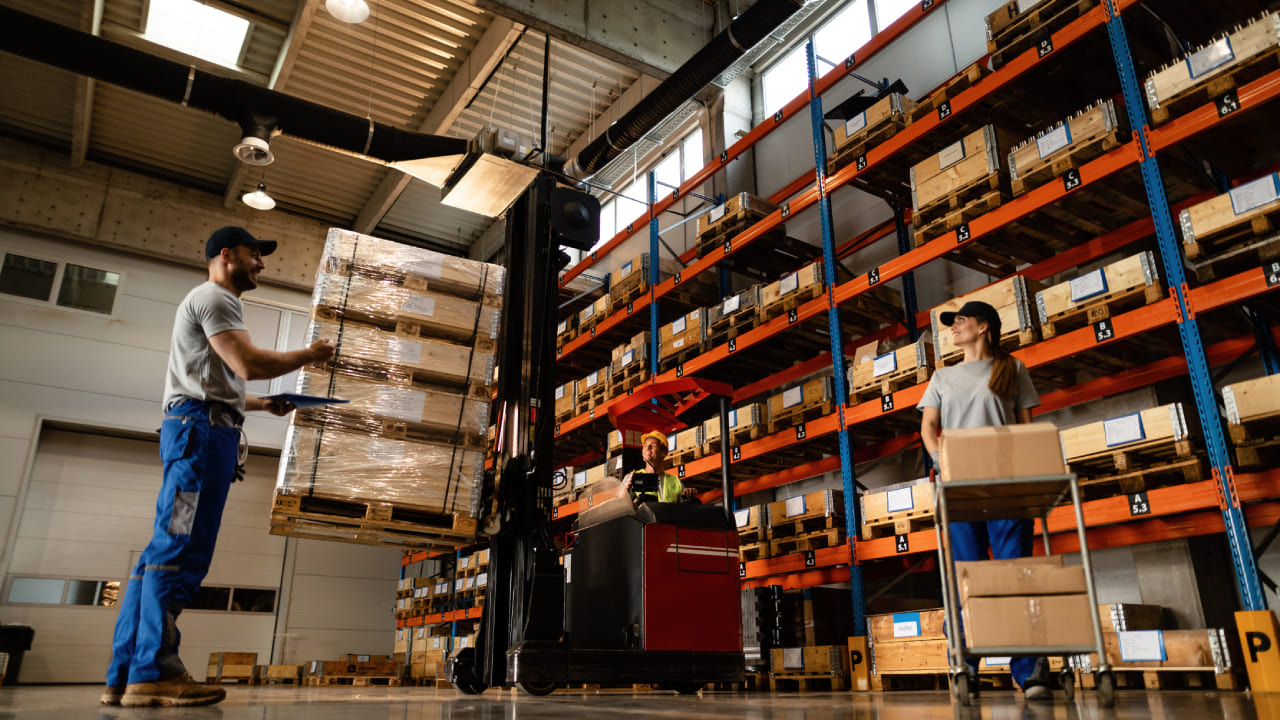Automated Warehouse Logistics: Improving Efficiency and Accuracy
Warehouses confront significant obstacles today. Overload of tasks with time constraints, inaccuracies in orders, and elevated expenses can hinder progress. This is when mechanized warehouse logistics becomes useful.
It’s an effective method to manage these issues.
Automated warehouse logistics employs machines and software to improve warehouse efficiency. It assists in quick order dispatch, reduces errors, economizes on expenditure, and ensures the safety of workers. Plan your logistics operations smartly with insights from our business plan writers.
Our article intends to enlighten you about how this technology can positively alter your warehouse operations. Eager to gain more insights? Do continue to read.

On this page
- What is Automated Warehouse Logistics?
- Components of Automated Warehouse Logistics
- Automated Storage and Retrieval Systems (ASRS)
- Automated Guided Vehicles (AGVs) and Autonomous Mobile Robots (AMRs)
- Conveyor Systems and Sortation Technology
- Warehouse Management Software (WMS)
- Benefits of Using Automated Warehouse Logistics
- Increased Efficiency
- Enhanced Accuracy
- Cost Savings
- Improved Safety
- Scalability and Flexibility
- Challenges and Considerations in Implementing Automated Warehouse Logistics
- Future Trends in Automated Warehouse Logistics
- Is Automation Suitable for All Types of Warehouses?
- What is the Potential Return on Investment (ROI) for Automated Warehouse Logistics?
- Final Thoughts
What is Automated Warehouse Logistics?
Automated Warehouse Logistics points to the incorporation of technology and robotics in warehouses to augment efficiency and precision.
This system is composed of diverse elements such as automated storage and retrieval systems, barcode scanning, conveyor belts, and inventory management software.
It aids companies in transporting goods through their warehouses quicker and with minute errors.
Enterprises leverage Automated Warehouse Logistics to reduce labor expenditures, hasten delivery periods, and monitor inventory in real time.
Components of Automated Warehouse Logistics
Automated warehouse logistics leverages technology to streamline processes, optimize inventory management, and improve overall productivity.
This approach relies on several key components working seamlessly together to orchestrate the flow of goods within a warehouse.
Transform your vision into reality
Hire our professional
expert business plan writer today!
Automated Storage and Retrieval Systems (ASRS)
Automated Storage and Retrieval Systems (ASRS) modify the method warehouses employ for item storage.
These systems employ robots and machinery to position and recover commodities from designated areas in a warehouse.
They simplify material handling and inventory management. ASRS technology allows workers to concentrate on alternate tasks, enhancing workplace effectiveness.
Automated Guided Vehicles (AGVs) and Autonomous Mobile Robots (AMRs)
Automated Guided Vehicles (AGVs) and Autonomous Mobile Robots (AMRs) are modifying the approach to material movement in warehouses.
AGVs adhere to specified routes to move items across distinct sectors within a facility, presenting a reliable answer for recurring tasks.
Contrarily, AMRs feature sophisticated navigation technologies enabling them to comprehend their surroundings and transfer materials proficiently without human activity.
These robots significantly reduce labor expenses and enhance delivery schedules by ensuring goods are selected, packed, and categorized with high precision.
Conveyor Systems and Sortation Technology
Conveyor systems and sortation technology are essential for optimizing warehouse operations. They efficiently move items throughout the facility, improving material handling and order fulfillment processes.
Barcode scanning and automated picking systems guarantee accurate and swift movement of goods, thus reducing delivery times significantly.
Warehouse Management Software (WMS)
Warehouse Management Software (WMS) plays a vital role in automated warehouse logistics, enhancing inventory management and order fulfillment.
Many businesses pair WMS with the best inventory management systems to monitor stock levels, streamline replenishment, and ensure inventory moves efficiently throughout the supply chain.
WMS incorporates barcode scanning and real-time data for efficient material handling and optimized workflows.
It allows precise monitoring of inventory levels, thereby improving supply chain efficiency and reducing delivery times.
Benefits of Using Automated Warehouse Logistics
Automated Warehouse Logistics offers increased efficiency and enhanced accuracy in inventory management. Integrating automation into your operations plan with guidance from business plan writers can boost efficiency. It also brings about cost savings, and improved safety, and provides scalability and flexibility for business operations.
Increased Efficiency
Automated warehouse logistics significantly improve efficiency by streamlining material movement and order fulfillment.
Robotics, conveyor systems, and sorting technology reduce delivery times and minimize labor costs.
Automated picking systems enhance supply chain efficiency by optimizing picking and sortation processes with barcode scanning, leading to faster inventory control.
The use of automated storage and retrieval systems (ASRS) enhances efficiency optimization through quick access to inventory.
Enhanced Accuracy
To achieve optimal accuracy, automated warehouse logistics utilize advanced technologies such as barcoding and scanning systems integrated with warehouse management software (WMS).
These systems ensure precise inventory control and order fulfillment, reducing errors in picking and sorting.
Automated storage and retrieval systems (ASRS) enhance accuracy by removing human error in material handling tasks, minimizing discrepancies and improving overall inventory accuracy.
Additionally, robotics play a crucial role in improving accuracy within warehouses. Automated picking systems use robotic arms to precisely handle items for order fulfillment while barcode scanning technology ensures accurate tracking of products throughout the supply chain.
Cost Savings
Improved precision in automated warehouse logistics directly results in significant cost savings for business owners, e-commerce, and warehouses.
Businesses can decrease labor costs while achieving precise order fulfillment and delivery times by reducing errors and optimizing inventory management with barcode scanning and automated picking systems.
The use of robotics in logistics leads to efficient palletizing and sorting automation, further reducing operational costs while maintaining a smooth supply chain.
Embracing technology-driven efficiency optimization proves crucial in reducing labor costs and fostering sustainable growth within the industry.
Improved Safety
Automated warehouse logistics significantly improve safety in the workplace. By employing advanced technologies such as Automated Guided Vehicles (AGVs) and Autonomous Mobile Robots (AMRs), the risk of accidents related to manual material handling is significantly reduced.
These systems are equipped with sensors, cameras, and collision avoidance features that ensure a secure working environment for employees while navigating through the facility.
Automated Storage and Retrieval Systems (ASRS) minimize the need for workers to access high shelves or confined spaces, mitigating potential injury risks associated with traditional warehouse operations.
Scalability and Flexibility
Automated warehouse logistics offer flexibility and adaptability to adjust to changing business needs.
As demand fluctuates, automated systems can easily modify operations to accommodate varying inventory levels and order volumes efficiently.
This flexibility allows businesses to adjust their operations as necessary without major disruptions, ensuring smooth and cost-effective management of inventory fluctuations.
Incorporating adaptable automation technology enables warehouses to handle a wide range of products and packaging types, from small items to large pallets, without requiring extensive retooling or manual adjustments.
Challenges and Considerations in Implementing Automated Warehouse Logistics
Implementing Automated Warehouse Logistics presents opportunities such as the significant initial investment and the complexity of integrating with existing systems. Additionally, it calls for a skilled workforce to operate and maintain the automated technology effectively.
- High initial investment: Implementing automated warehouse logistics involves a significant initial investment, covering the cost of advanced technologies such as Automated Storage and Retrieval Systems (ASRS), Automated Guided Vehicles (AGVs), and Warehouse Management Software (WMS).
- Complexity of integration with existing systems: Integrating automated warehouse logistics with existing systems can present intricate challenges for businesses. The interoperability of automated storage and retrieval systems (ASRS), conveyor systems, and warehouse management software (WMS) requires detailed planning to ensure smooth coordination.
- Need for a Skilled Workforce: Implementing automated warehouse logistics necessitates a skilled workforce well-versed in robotics, technology, and inventory management. Employees must excel in operating and maintaining automated storage and retrieval systems (ASRS), conveyor systems, and warehouse management software (WMS).
- Potential for Job Displacement: Implementing automated warehouse logistics can lead to job displacement as tasks traditionally performed by human workers are taken over by machines. This shift can result in a reduction in the need for manual labor, impacting roles such as inventory management, order fulfillment, and material handling.
Future Trends in Automated Warehouse Logistics
Automation in warehouse logistics is advancing rapidly, driven by technological innovation and market demand.
The future will witness a surge in the integration of AI and machine learning for predictive analytics to optimize inventory management and order fulfillment processes.
Robotics will further evolve to handle complex tasks such as item picking, packing, and sortation, enhancing efficiency and reducing labor costs.
There will be an increased focus on sustainability with the implementation of energy-efficient systems and eco-friendly packaging solutions.
The seamless synchronization of warehouse management software with IoT-enabled devices will revolutionize real-time tracking of material movement, leading to reduced delivery times and enhanced supply chain efficiency.
Grow Your Business Now, Analyze Data Today!
Is Automation Suitable for All Types of Warehouses?
Automation varies in its applicability to warehouses. Despite the advantages it offers in terms of enhanced efficiency and accuracy, its feasibility hinges on factors such as the nature of handled products, order volumes, and operational procedures.
Automated systems might be well-matched for large-scale e-commerce fulfillment centers dealing with standardized products.
However, they could pose challenges in smaller warehouses managing a diverse range of items or necessitating frequent reconfiguration.
Understanding the distinct requirements and complexities of individual warehouse operations is critical to gauging the viability and advantages of automation.
When evaluating the suitability of automation for different warehouse types, it is crucial to consider factors such as inventory turnover rates, SKU diversity, order profiles, and spatial limitations.
What is the Potential Return on Investment (ROI) for Automated Warehouse Logistics?
Implementing automated warehouse logistics can yield a significant return on investment (ROI) due to increased efficiency and cost savings.
By employing robotics, barcoding, and conveyor systems, businesses can significantly reduce labor costs while optimizing inventory management and order fulfillment.
According to industry data, companies that invest in automated picking systems experience up to a 50% decrease in their operational expenses.
The use of automated storage and retrieval systems leads to improved inventory accuracy of up to 99.9%, minimizing costly errors and reducing the need for manual intervention.
Final Thoughts
Automated Warehouse Logistics enhances efficiency and accuracy, propelling businesses to new heights. Robotics and technology optimize inventory management while reducing labor costs.
This revolutionary system enhances supply chain efficiency, streamlining delivery times and driving business growth.
With automated warehouse logistics, businesses can unlock unmatched potential for success in today’s ever-evolving digital landscape.

